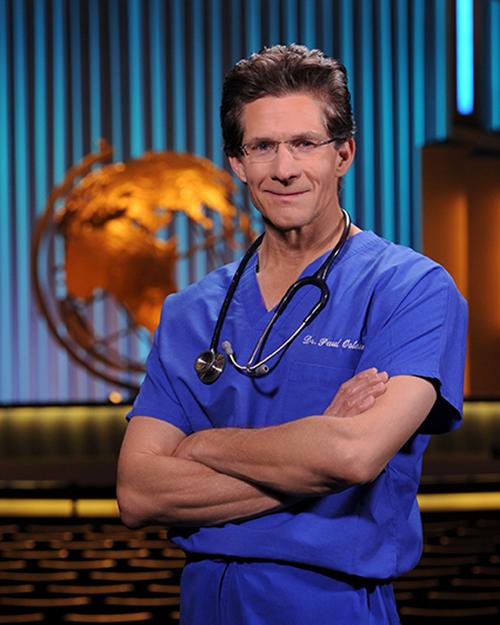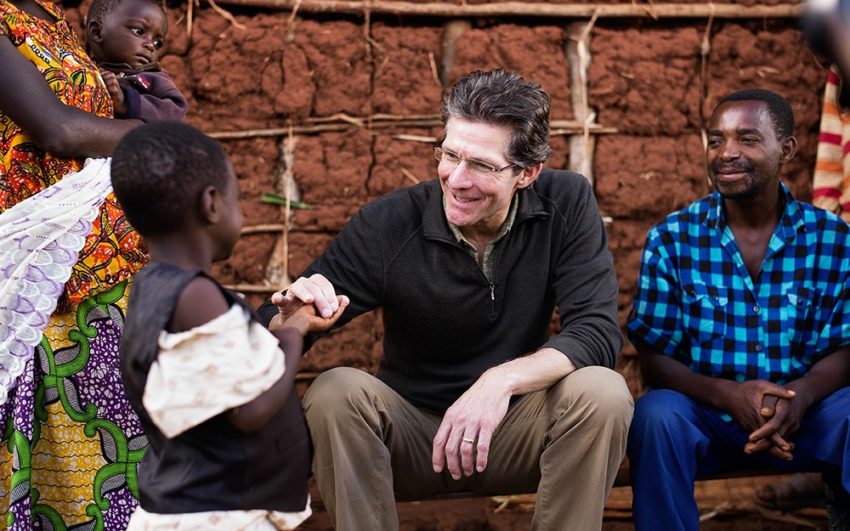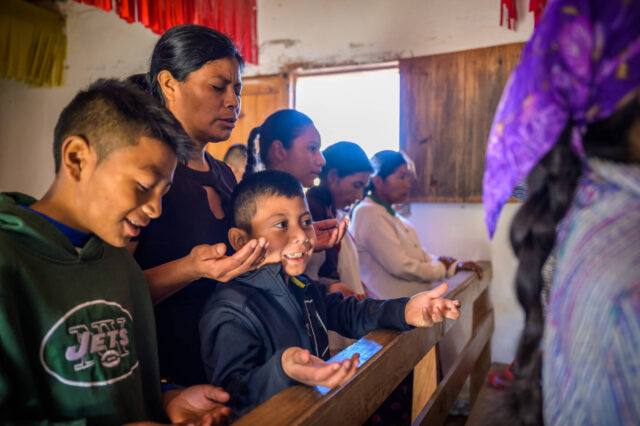Dr. Paul Osteen was stunned when he met Kipkurui. The 14-year-old boy had been unable to eat for two years, could barely stand, and weighed about 50 pounds. He showed up wearing the only thing he owned, a girl’s faded and tattered flower dress.
After days of tests, the medical team at Tenwek missionary hospital in Bomet, Kenya, determined Kipkurui had an intestinal obstruction. Paul operated and removed a band of scar tissue blocking the boy’s intestines.
While Kipkurui recovered, Paul Osteen, the older brother of Pastor Joel Osteen, asked the hospital chaplain to visit and encourage the family with a Bible verse, Jeremiah 29:11.
‘For I know the plans I have for you,’ declares the Lord, ‘plans to prosper you and not to harm you, plans to give you hope and a future.’—Jeremiah 29:11 (NIV)
“Pastor Helen called me so excited,” Paul writes in his blog, “she informed me that both Kipkurui and his mother accepted Jesus as their Savior.
“Kipkurui left Tenwek hospital a couple of weeks later — on his way to regaining his health, with some new clothes and shoes, a warm coat for the cool nights, and the firsthand knowledge that, there on a hill in western Kenya, is a group of people who demonstrate the love, compassion, and care of our Savior.”
“It’s almost reverse evangelism,” Paul says during an interview. “They come to you. You bless them; you care for them; many of them accept Jesus. They go back and tell people, ‘Those people love me; they showed me the kindness of God.’”
A new partnership between Lakewood Church and World Vision
If Joel Osteen is the well-known face and voice of Lakewood Church in Houston, then older brother Paul Osteen represents that church’s hands and feet. One ministers in front of millions through television. The other ministers hands-on, one-to-one, in some of the most remote and poorest parts of the earth.
Influenced by World Vision U.S. President Rich Stearns’ book The Hole in Our Gospel, Paul is leading a new partnership between World Vision and Lakewood Church. He visited his sponsored child in Rwanda and says the partnership is a good fit.
“We share the same heart to help bring people up, people who are hurting,” Paul says. “It’s more than giving food. If we can’t elevate the poor out of poverty and elevate them to become self-sustaining, we’ve just put a Band-Aid on it. There’s nothing wrong with putting a Band-Aid on it. But it’s far more beneficial to me to elevate people. What I saw in Rwanda was exactly that.”
We share the same heart to help bring people up, people who are hurting.—Dr. Paul Osteen
Through the partnership, more than 10,000 children around the world have been sponsored at A Night of Hope events, which are held by Joel and Victoria Osteen at some of the country’s largest venues. In addition, World Vision is partnering with Lakewood Church’s ongoing ministry in Houston’s Fifth Ward, where nearly half the residents live below the U.S. poverty level, providing technical expertise in long-term community development.
With World Vision, Lakewood is reaching out to Zambia, El Salvador, Indonesia and India, countries where the church sponsors about 5,000 children each year.
Recently a team from Lakewood Church returned from El Salvador where they met sponsored children and toured nutrition, preschool, after-school and Bible reading programs funded primarily by World Vision sponsorship. The church is also planning to partner next year with 60 small churches in Indonesia, ministering to the ministers, as well as supporting work in the slums of Bangalore, India.
A general and vascular surgeon for 17 years in Little Rock, Arkansas, Dr. Paul, as he’s known around Lakewood, left his practice at the height of success to return to Houston and minister at the church in 1999.
He served as an executive pastor for a decade, overseeing the church’s ministries. About five years ago, he returned to surgery and the mission field. For four to six months each year, he travels, often with his family, to relieve missionary doctors and surgeons in Kenya and Zambia while they go on furlough.
“We, as the American church, can’t get so insulated that we forget poor, suffering people,” Paul says. “If we in the church become so religious we look the other way, it’s a sad thing.”
Two callings
When he was a young boy, Paul sensed he was headed down a different path than his father, John Osteen, who started Lakewood Church in 1959 in an abandoned feed store in northeast Houston.
He remembers his family’s china closet, where his mother, Dodie, used to keep a few things she had as a nurse.
“One of them was a pair of bandage scissors,” Paul says. “I just remember putting those bandage scissors in my hands and feeling that’s really what I want to do, to help people.”
Through high school and at Oral Roberts University in Tulsa, Oklahoma, his yearning to pursue a medical career were honed into skills. He graduated from medical school in 1982. Paul was in the first class, and the timing, he says, “was a God thing for me.”
He ended up going to University of Arkansas for his residency and was invited to join a surgical practice there. He and his wife, Jennifer, a registered nurse, began to put down roots.
Then, in 1999, his father died unexpectedly of a heart attack and stroke. After the services, Paul was driving the family back to Little Rock when their lives took another direction. On U.S. 59, less than an hour from Houston, three sentences came to him: Give up your practice. Move to Houston. And help.
He repeated the sentences to himself. It was illogical. But the impression was overwhelming: “I will bet my life on those words,” Paul says. “That’s how strong it was.”
He took about two weeks to think about it. His sister and confidante, Lisa, asked him one question.
“’Paul, do you think God spoke to you?’” Paul recounts the conversation. “I said, ‘There’s no doubt in my mind he spoke to me.’ And she said, ‘Well, then you have two choices — obey or disobey. And our family always obeys.’”
Later that year, Paul moved his family to Houston and embraced an uncertain future. What was going to happen at Lakewood? Joel was new to preaching. Would the church lose membership?
Church attendance did not fall — it skyrocketed, limited only by the ability of the roads to handle traffic around the church.
“All of the sudden, we just were getting into this vein of encouragement that flowed from deep inside [Joel’s] soul,” Paul says. “It became very obvious what he was doing was really working, encouraging people; his message resonated with people.”
The church with a weekly attendance of roughly 5,000 to 6,000 grew to 43,500 average attenders each Sunday. To accommodate the growth, in 2005, Lakewood moved into the former Compaq Center, which had housed the NBA’s Houston Rockets. Paul, who oversaw the pastoral ministries during that time, was the 29th employee on the church roll. Today, the church has more than 300 full- and part-time employees. On top of the local growth and reach, Joel’s weekly television broadcast reaches millions internationally and is the top inspirational show in the U.S. market.
To the mission field
It had been years since Paul practiced medicine. But while on a medical missions trip, he was asked to help in the operating room. He thought he had left that career behind; he’d “put it on the altar, and it was dead, so to speak,” he says.
But as he helped, the plastic surgeon he was assisting said, “Paul, you can still operate.” The next day, he helped again in the operating room, “and it was like I never missed a beat. You can just say it was good training and other surgeons have done that too, coming back, but it was supernatural.”
He was asked to come back and help for five weeks. The next time it was 10 weeks; the next time, three and a half months; the next time, four months.
“I would speak on Wednesday nights [at Lakewood] and as this thing was blossoming, Joel said, ‘Paul, take as much time as you want; take six months of the year.’ That resonated with my spirit.”
Chapel at 7:30 a.m., rounds at 8 a.m., 30 to 40 patients in the clinic or in the operating room all day. When Paul was working in Zambia last year, he was one of the only qualified surgeons in an area the size of Louisiana.
“There’s very little surgical care. That means mom and baby die in childbirth. That means you die of appendicitis. That means without care for malaria, you die of malaria,” he says. “We had 10 people die one night in one of the hospitals.”
With medical care scarce, it’s not unusual to find people who will walk weeks and miles to get to the clinic.
During one assignment at Chitokoloki Mission Hospital in Zambia, a woman arrived suffering from a stick that had pierced her eye.
“And I said, through a translator, when did this happen to her? She said four days ago. I said, ‘Why did you wait so long?’ She said, ‘I started walking when I got the injury.’ So, she walked for four days.”
Bringing hope
In 2010, a year after Kipkurui, the 14-year-old boy who weighed 50 pounds, came to Tenwek Hospital in Kenya, Paul hired a driver and four-wheel-drive vehicle to find his village and visit.
For a couple of hours, they crisscrossed the hilly region of southeast Kenya before finding his village and home.
“When I saw his face and his smile and felt his warm embrace,” Paul writes in his blog, “I was reminded that it is such a privilege to be a small part of bringing hope and help to people just like Kipkurui. Just one face in the hundreds I’ve seen … but one I won’t soon forget.”

Dr. Paul Osteen
Title: Associate pastor, Lakewood Church, Houston
Emphasis: Oversees Lakewood Church’s partnership with World Vision
Background: General and vascular surgeon, 17 years, Little Rock, Arkansas
What you don’t know: He loves ranching. At one time, he had a 55-acre ranch outside Houston.


